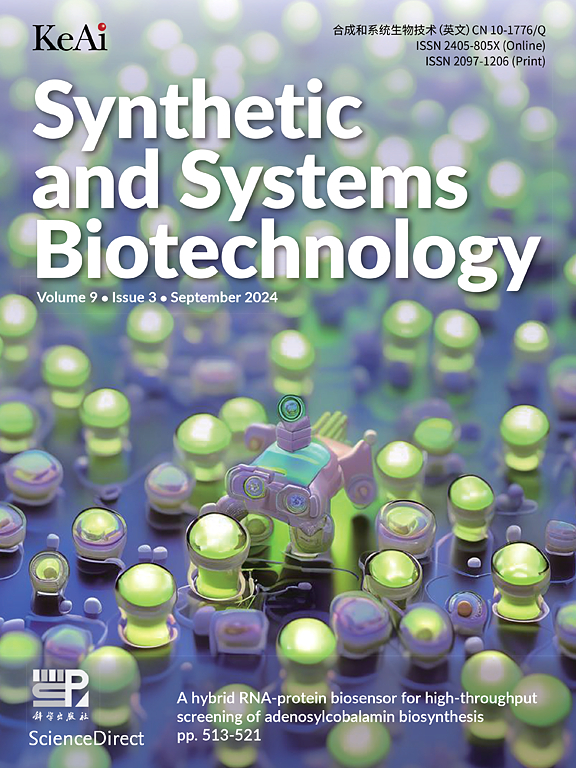利用出口工程和培养基组成的贝叶斯优化提高谷氨酸棒状杆菌的l-丝氨酸合成
IF 4.4
2区 生物学
Q1 BIOTECHNOLOGY & APPLIED MICROBIOLOGY
引用次数: 0
摘要
l-丝氨酸是一种多用途、高附加值的氨基酸,广泛应用于食品、医药、化妆品等领域。然而,l-丝氨酸的低效价限制了它的工业生产。本研究以运输工程为基础,构建了高效生产l-丝氨酸的无质粒细胞工厂。首先,研究了l-丝氨酸输出源SerE过表达和缺失对谷氨酰胺棒状杆菌A36细胞生长和l-丝氨酸滴度的影响,通过质粒过表达SerE可使l-丝氨酸滴度提高15.1%,但也会使细胞生长降低15.1%。随后,为了提高SerE的出口能力,我们进行了半理性设计和生物信息学分析,结合丙氨酸突变和位点特异性饱和突变。获得突变体E277K,与野生型SerE相比,其输出能力提高了53.2%,l-丝氨酸滴度提高了39.6%。通过结构分析和分子动力学模拟来阐明其机理。结果表明,该突变缩短了输出体与l-丝氨酸之间的氢键距离,增强了配合物的稳定性,降低了结合能。最后,采用贝叶斯优化进一步提高突变株C-E277K的l-丝氨酸滴度。在优化的条件下,在5-L的生物反应器中,L -丝氨酸可达47.77 g/L,是迄今为止报道的谷氨酰胺的最高滴度。该研究为l-丝氨酸输出途径的转变提供了依据,并为提高l-丝氨酸滴度提供了新的策略。本文章由计算机程序翻译,如有差异,请以英文原文为准。
Enhanced l-serine synthesis in Corynebacterium glutamicum by exporter engineering and Bayesian optimization of the medium composition
l-serine is a versatile, high value-added amino acid, widely used in food, medicine and cosmetics. However, the low titer of l-serine has limited its industrial production. In this study, a cell factory without plasmid for efficient production of l-serine was constructed based on transport engineering. Firstly, the effects of l-serine exporter SerE overexpression and deletion on the cell growth and l-serine titer were investigated in Corynebacterium glutamicum (C. glutamicum) A36, overexpression of serE using a plasmid led to a 15.1% increase in l-serine titer but also caused a 15.1% decrease in cell growth. Subsequently, to increase the export capacity of SerE, we conducted semi-rational design and bioinformatics analysis, combined with alanine mutation and site-specific saturation mutation. The mutant E277K was obtained and exhibited a 53.2% higher export capacity compared to wild-type SerE, resulting in l-serine titer increased by 39.6%. Structural analysis and molecular dynamics simulations were performed to elucidate the mechanism. The results showed that the mutation shortened the hydrogen bond distance between the exporter and l-serine, enhanced complex stability, and reduced the binding energy. Finally, Bayesian optimization was employed to further improve l-serine titer of the mutant strain C-E277K. Under the optimized conditions, 47.77 g/L l-serine was achieved in a 5-L bioreactor, representing the highest reported titer for C. glutamicum to date. This study provides a basis for the transformation of l-serine export pathway and offers a new strategy for increasing l-serine titer.
求助全文
通过发布文献求助,成功后即可免费获取论文全文。
去求助
来源期刊

Synthetic and Systems Biotechnology
BIOTECHNOLOGY & APPLIED MICROBIOLOGY-
CiteScore
6.90
自引率
12.50%
发文量
90
审稿时长
67 days
期刊介绍:
Synthetic and Systems Biotechnology aims to promote the communication of original research in synthetic and systems biology, with strong emphasis on applications towards biotechnology. This journal is a quarterly peer-reviewed journal led by Editor-in-Chief Lixin Zhang. The journal publishes high-quality research; focusing on integrative approaches to enable the understanding and design of biological systems, and research to develop the application of systems and synthetic biology to natural systems. This journal will publish Articles, Short notes, Methods, Mini Reviews, Commentary and Conference reviews.
 求助内容:
求助内容: 应助结果提醒方式:
应助结果提醒方式:


